Application Of PVDF-Based Electroactive Polymers For Improving Performance In Soft Robotics
Technology Background And Goals
In this report, you will explore the potential applications of PVDF-based electroactive polymers in enhancing the performance of soft robotics. These polymers exhibit unique properties such as piezoelectricity, pyroelectricity, and ferroelectricity, making them attractive for use in soft robotic systems.
Key areas of focus include leveraging the electroactive properties of PVDF to develop advanced actuators, sensors, and energy harvesting mechanisms for soft robots. This could enable improved dexterity, sensitivity, and self-powering capabilities, leading to more versatile and efficient soft robotic systems for various applications, such as biomedical devices, wearable technologies, and exploration robots.
Market Demand Analysis
- Market Size and Growth
The market for PVDF-based electroactive polymers in soft robotics is expected to witness significant growth in the coming years. The increasing demand for advanced materials in robotics, coupled with the unique properties of PVDF, is driving market expansion. - Key Applications
PVDF-based electroactive polymers find applications in various soft robotic systems, including:- Artificial muscles and actuators
- Flexible sensors and energy harvesters
- Soft grippers and manipulators
- Wearable and assistive devices
- Industry Trends
The soft robotics industry is witnessing a growing demand for lightweight, flexible, and compliant materials that can mimic biological systems. PVDF-based electroactive polymers align with this trend, offering unique advantages over traditional rigid materials. - Competitive Landscape
The market for PVDF-based electroactive polymers is highly competitive, with several players operating globally. Key players include specialized material manufacturers, research institutions, and robotics companies exploring the potential of these materials.
Technology Status And Challenges
- Technological Evolution
PVDF-based electroactive polymers have undergone significant advancements, transitioning from basic materials to advanced composites and nanostructures, enabling enhanced performance and functionality. - Material Innovations
Researchers have explored various material modifications, such as copolymerization, nanocomposites, and surface treatments, to improve electromechanical properties and tailor material characteristics. - Processing Techniques
Novel processing methods, including electrospinning, 3D printing, and self-assembly, have been developed to fabricate PVDF-based electroactive polymer structures with controlled morphologies and architectures. - Characterization Advancements
Advanced characterization techniques, such as in-situ measurements, computational modeling, and multi-scale analysis, have enabled a deeper understanding of the structure-property relationships and performance optimization. - Emerging Applications
PVDF-based electroactive polymers have found applications in various fields, including soft robotics, energy harvesting, biomedical devices, and smart textiles, driving further research and development.
Current Technical Solutions
01 Energy Harvesting and Sensing Applications
PVDF-based electroactive polymers exhibit piezoelectric and pyroelectric properties, enabling their use in energy harvesting and sensing devices like sensors, actuators, and energy harvesters.- Energy Harvesting and Sensing Applications: PVDF-based electroactive polymers exhibit piezoelectric and pyroelectric properties, enabling energy harvesting and sensing applications. They can convert mechanical energy into electrical energy or detect changes in temperature, pressure, or strain.
- Actuator and Transducer Applications: PVDF-based electroactive polymers can act as actuators or transducers, converting electrical energy into mechanical energy or vice versa. They can be used in loudspeakers, microphones, and vibration control systems.
- Polymer Composites and Blends: PVDF-based electroactive polymers can be combined with other materials like ceramics, carbon nanotubes, or conductive fillers to form composites or blends with enhanced properties, such as improved mechanical, electrical, or thermal characteristics.
- Processing and Fabrication Techniques: Various techniques like electrospinning, solution casting, and melt processing can be used to fabricate PVDF-based electroactive polymers into different forms, including films, fibers, and porous structures. The processing methods influence the polymer's crystalline structure and electroactive properties.
- Characterization and Modeling: Techniques like X-ray diffraction, FTIR spectroscopy, and dielectric measurements are used to characterize the structure and properties of PVDF-based electroactive polymers. Computational modeling and simulations are also employed to understand and predict their behavior under various conditions.
02 Biomedical Applications
PVDF-based electroactive polymers have been explored for biomedical applications, including tissue engineering scaffolds, drug delivery systems, and biosensors, due to their biocompatibility, piezoelectric properties, and ability to promote cell growth.Expand Specific Solutions03 Polymer Composites and Blends
PVDF-based electroactive polymers can be combined with other materials like ceramics, carbon nanotubes, or conductive fillers to form composites or blends with enhanced mechanical, electrical, or thermal properties for various applications.Expand Specific Solutions04 Energy Storage Applications
PVDF-based electroactive polymers have been investigated for energy storage applications, such as capacitors and batteries, due to their high dielectric constant and electroactive properties, making them suitable as dielectric materials or electrode coatings.Expand Specific Solutions05 Processing and Fabrication Techniques
Various processing and fabrication techniques, including electrospinning, solution casting, and melt processing, have been developed for PVDF-based electroactive polymers, allowing the production of films, fibers, or other structures with desired properties and morphologies for specific applications.Expand Specific Solutions
Main Player Analysis
Arkema France SA
SABIC Global Technologies BV
Key Technology Interpretation
- Using low levels of ionizing radiation to increase the melt strength and elasticity of PVDF-based polymers without changing their chemical composition.
- Producing solvent-resistant fluoropolymer foams with good mechanical integrity at elevated temperatures by using ionizing radiation to partially crosslink the polymer.
- Thermoforming and crosslinking of foams using low levels of ionizing radiation to create dense, flexible materials.
Economic Analysis
The economic impact of PVDF-based electroactive polymers in soft robotics is multifaceted, contributing to both the robotics industry and broader economic sectors. These materials facilitate the development of lightweight, flexible, and energy-efficient robotic systems, promoting advancements in manufacturing and automation. The integration of such polymers can significantly reduce production costs due to their inherent properties, which enable simpler design and construction of robotic components.
In the medical field, the adoption of soft robotics for minimally invasive surgical tools and prosthetics expands market opportunities, offering solutions that potentially reduce healthcare costs and improve patient outcomes. Additionally, the environmental sector benefits from soft robotics' contribution to sustainable practices, including renewable energy harvesting and pollution monitoring.
The market demand for soft robotics is projected to grow, driven by increasing investments in automation and the pursuit of sustainable technologies. Economic growth may be stimulated through job creation in research, development, and manufacturing sectors related to these polymers. As countries seek to enhance their technological capabilities, the proliferation of PVDF-based electroactive polymers underscores an economic shift towards more innovative and adaptable technologies, aligning with global trends in digital transformation.
Policy And Regulatory Impact
The regulatory landscape for PVDF-based electroactive polymers in soft robotics is complex, given the emerging nature of this field. The development and deployment of these materials are influenced by policies related to material safety, environmental impact, and technology standards. Key regulations focus on ensuring the non-toxicity and biocompatibility of PVDF materials, as these are often used in applications involving human interaction, such as wearable robotics and medical devices. International standards organizations are beginning to establish guidelines for electroactive polymers, aiming to harmonize safety and performance metrics across borders.
Additionally, environmental regulations are significant, as the production and disposal of PVDF must align with sustainability goals and pollution control measures. The market entry for these technologies could be impacted by potential regulatory changes aimed at limiting the use of hazardous substances. Furthermore, intellectual property rights play a crucial role, as patents and technology ownership can affect competitive dynamics and innovation pathways in the field.
Navigating these regulatory frameworks requires companies to engage with policymakers and industry groups to advocate for fair and predictable standards, while also ensuring compliance to avoid legal and financial repercussions. The evolving nature of regulations means that stakeholders must stay informed and adaptable to new requirements that may affect the research, development, and commercialization of PVDF-based electroactive polymers.



